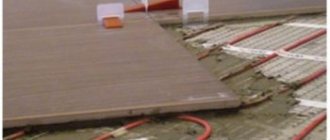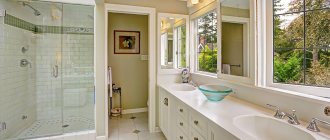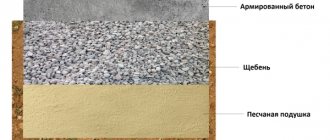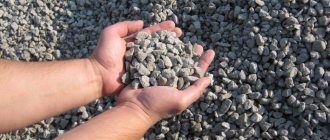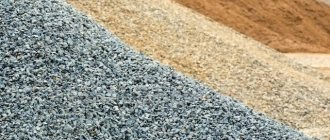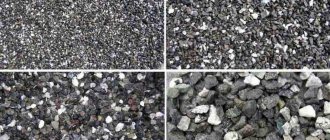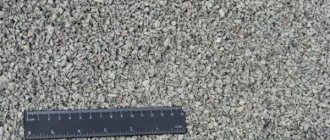Colored crushed stone. Photos of Soil Trucks
Crushed stone is a popular type of bulk materials. Various types of crushed stone are used in many fields of activity. Colored crushed stone is one of the types of materials according to the post-processing method , along with black, washed and tumbled.
Colored crushed stone is actively used in modern landscape design, but is also used in other areas of activity.
What kind of material is this, production
Colored decorative crushed stone is an artificially colored fractional stone . Several types of crushed stone are used for painting granite and marble, less often limestone. These breeds lend themselves best to dyeing. The technology for producing colored crushed stone includes several stages. The raw material is crushed stone of natural origin, the extraction of which includes determining the location of the future quarry, developing the deposit, cleaning the area, stripping, breaking the rock (several methods are used), crushing, screening (sifting) and sorting.
Fractions of marble crushed stone. Photo Petrovich
For painting, crushed stone sorted into fractions , then it is possible to immediately begin painting. If unsorted fractions act as raw materials, then the first technological stage will be sifting on a vibrating screen , hence the alternative name for the process - screening.
use high-quality products for painting that are resistant to weather influences: precipitation, direct sunlight, temperature changes. Manufacturers use acrylic or most often polymer paints , available in a wide range of colors, which are non-toxic, do not harm plants and do not come into contact with the soil.
Reference! Unscrupulous manufacturers use inexpensive paint products, which affects the service life of colored crushed stone, which begins to fade in the second year. Also, enterprises, to the detriment of quality, save on raw materials, quantity of paint, and drying process.
For painting, a special hopper , the operating principle of which is similar to the operation of a concrete mixer. The ratio of components loaded into the hopper is five parts crushed stone and one part paint. After painting, the crushed stone is placed in a drying chamber . The final stage is packaging. Bulk materials are sold in bags weighing 2-20 kilograms.
Directions for using crushed stone in site design
Landscape designers offer a variety of options for decorating a site with crushed stone. The most popular include:
- Arrangement of paths, flower beds. The selected space on the site is sprinkled with crushed stone. Here you should follow the rule: the smaller the area being sprinkled, the finer the crushed stone fraction. The technology of work is simple and accessible for independent use. First, create a small depression, fencing it around the perimeter with a border (coarse crushed stone can be used). Then a sand cushion, polyethylene with holes to absorb moisture from the surface and crushed stone are laid in turn.
- Creation of a rock garden. This design can cover “unsuccessful” areas of the garden, as it requires the use of a combined composition of crushed stone: both large and small. First, a base of crushed stone and gravel is formed. After installing the plantings, the free space is filled with crushed stone.
- Formation of a Japanese garden (dry rock garden). Finely graded crushed stone is laid on the site, along the surface of which stripes are drawn to simulate the movement of water. Then large boulders and evergreen shrubs are located in a chaotic manner. Such a composition requires special care: in order for the depicted waves to retain their texture, they should be periodically corrected.
- Decorating an artificial or natural reservoir on the site. Crushed stone can be used not only for sprinkling the coastal zone; a gravel bottom with boulders protruding from the water looks very natural.
- Arrangement of places for rest (near benches or gazebos). Since the crushed stone in its entirety has spaces between the stones, grass will certainly appear in the decorated areas after some time. To protect the site during its arrangement, cushioning material should be used. It is spread directly under the rubble. If polyethylene was used, then small holes are first made on it to ensure the passage of moisture from the surface into the soil.
Regardless of the chosen direction, territories decorated with stone have a number of advantages:
- You can decorate an area of the territory that is unused due to various reasons (shade, excessive soil moisture);
- Such fragments require virtually no maintenance;
- The amount of work on the site is reduced, because the beds sprinkled with crushed stone do not need to be periodically weeded or loosened;
- It won’t take a lot of money to create compositions;
- You can do the work yourself without inviting specialists.
How much area of the plot to decorate with decorative stone depends entirely on the wishes of the owners. The main thing is to ensure a harmonious look with the surrounding environment.
| < What soil is needed for a greenhouse? | How to choose the right crushed stone for the foundation? > |
Advantages of painted material
Colored crushed stone has numerous advantages . Since bulk material is used mainly to solve decorative problems in landscape design, we will consider the positive characteristics of crushed stone from this point of view:
- affordable price;
- high aesthetic qualities;
- wide color palette;
- long service life;
- resistance to ultraviolet radiation, moisture, low and high temperatures, and their changes;
- environmental Safety;
- operational safety for people, which allows the use of crushed stone for arranging playgrounds;
- if necessary, a landscape composition made of crushed stone can be easily removed, updated, or modified;
- possibility of repeated use;
- ease of installation, which does not require special skills, special tools and equipment;
- does not require maintenance, except for periodic leveling of the surface and removal of sprouting plant shoots;
- crushed stone allows water to pass through well and allows it to stagnate on the surface.
However, colored crushed stone also has several disadvantages:
- staining leads to the stones acquiring unnatural colors , as a result, the fractions often look cheap and not entirely aesthetically pleasing;
- paint may contain toxic substances;
- Even high-quality coatings fade over time ; non-compliance with painting technology by manufacturers can lead to other defects: the paint chips and comes off completely.
Marble chips in landscape design: exquisite decor
Feb 12/14
A natural and noble stone, marble is widely used not only in construction, but also for domestic purposes. Its waste is crushed for mulching in landscape design and serves as an excellent decoration in landscape art. At the same time, marble chips will not just decorate the area, but will also serve as protection against slipping, which is very important for garden paths wet from rain.
“Dream House” will talk today about the possibilities of using marble chips in the landscape design of a site.
Marble chips in landscape design
Shades and properties of marble chips
A scattering of faceted marble in white, milky, gray and any other shade will decorate the area of a country house like no other material. Modern production has mastered the technology and brought it into reality, which allows you to change the color scheme of the stone, as a result, design lovers receive a wide range of colors sufficient for creativity.
Popular articles How to furnish a gazebo in a loft style
Colored marble chips
Marble chips in landscape design photo
Decorating flower beds
Marble granules are used as an independent unit or combined with wood mulch. This option eliminates excess weeds around the flowerbed, and its shape will only be emphasized by the grace of the stone. It can “echo” the color scheme that was selected when planting the planting material.
Flowerbeds can be created on a flat surface or on a natural or artificially created hill in any container that turns out to be suitable for these purposes. If there is an elevation above the ground, an additional embankment of soil is decorated with marble chips.
The use of large granules: approximately 20 cm in diameter allows you to make a mound inside the flower bed. This method helps retain moisture, prevents the appearance of weeds and does not create a barrier to oxygen entering the ground.
The shades of the stone can echo the vegetation of the flower bed or be contrasting, but in any case everything should be harmonious.
Flower beds made of colored marble chips
Flowerbed made of marble chips photo
Marble chips for landscape
Decoration of artificial reservoirs
In this case, you can create an approach on only one side, smoothly transitioning from the general path. The remaining free perimeter near the water should be decorated with vegetation. If there is a bridge over a natural or artificial pond, the path to it will complement the design of the decorative bridge. Use the shades contained in it, and the landscape will become more harmonious.
Marble chips in the design of a pond and rock garden
Marble chips in landscape design photo
Marble chips in landscape design photo
Marble chips in landscape design photo
Decorating the alley
The color scheme and size of granules of marble chips allows you to create unique combinations of decorative decorations for alleys, garden paths, central or secluded areas, paths leading in different directions. An area designed in this way will always be well-groomed and free from the possible germination of unplanned grass.
Garden paths made of marble chips photo
Paths made of marble chips
Alley of marble chips
Paths on the site made of marble chips
The relative cheapness of such a wonderful material, which does not require special equipment for forming an embankment, makes marble chips accessible in terms of price and technical parameters for creating original solutions in landscape design.
5)
Areas of application: for landscape design, for the garden and more
Decorative crushed stone is a universal material used to solve a number of problems in landscape design and more:
Crushed stone is a popular decorative material. Photos of Soil Trucks
- creation of multi-colored volumetric and flat compositions in areas for various purposes: administrative, public (parks, squares, playgrounds), private;
- arrangement of paths and platforms;
- pouring mosaic areas and floors;
- mulching the soil;
- production of decorative plaster, paving slabs, decorative elements;
- design of sports grounds, fields, courts, flower beds, flower beds;
- arrangement of blind areas around houses, country houses and other outbuildings;
- creation of alpine slides and dry streams;
- construction of fences and gabions;
- framing monuments, steles, obelisks, tombstones;
- laying out the bottom of artificial and natural reservoirs and their banks;
- decoration of aquariums, pots with plants, etc.;
- finishing of various buildings both inside and outside.
Laying technology
An important advantage of colored crushed stone is its ease of use. Not only professionals, but also people without special construction and design skills can work with it. The technology for laying crushed stone (regardless of the tasks being performed: be it filling the territory, creating drawings, arranging paths, etc.) includes several stages:
- marking the area where the work will be carried out is carried out using pegs and a rope, which is stretched, connecting the pegs into the desired shape;
- in the marked area, the top layer of soil approximately 10 cm thick and plant rhizomes are removed, a shovel and rake are used;
- limiters are installed along the external boundaries, which are used as curbs, large stones, boards, planks, tape, etc.;
Reference. The installation of the limiter, depending on its type, is carried out either directly on the ground or on a previously prepared cement-sand cushion.
- a layer of sand 3-5 cm thick is poured onto the surface inside the figure, which is compacted and spilled with water to prevent shrinkage;
Reference. An alternative and more thorough, but at the same time more labor-intensive option is to install a concrete screed on a sand bed.
- waterproofing material is laid on a layer of sand;
- another layer of sand 3 cm thick is poured onto the waterproofing;
- The final stage is filling the figure with crushed stone and leveling it.
Methods and ideas for use in landscape design
There are many ways and ideas for using stone chips in landscape design. Most often, flower beds and ponds are decorated with natural materials. You can also decorate the garden in the form of a dry stream. Paths and paths made of small stones will look beautiful among the greenery and flowers.
Important! The stone chips should be laid out so that they completely cover the geotextile. General rules for laying stone chips:
General rules for laying stone chips:
- Remove top layer of soil.
- Pour a thin layer of sand (this is necessary so that rain can easily seep into the ground).
- Lay a special fabric on the sand - geotextiles (this material allows moisture to pass through well and will not allow weeds to grow).
- Lay out a layer (about 5 cm) of crushed stones.
What follows is a detailed description of decor ideas and materials that are suitable for creating an original garden exterior.
Decor for flower beds and ponds
Marble chips are perfect for decorating flower beds. Crushed marble comes in many sizes and colors, so choosing the right material is not difficult.
Find out also about the use of a well in landscape design.
Having selected a material suitable in size and color, you can begin laying it. To do this, marble crushed stone must be laid out in the manner described above. Then you can form the pattern. Sand, as well as smaller marble stones, are suitable for drawing. It is advisable to choose a contrasting color for the stones. Sand can be sprinkled on the main pattern formed from small fractions. Plants can be sprinkled at the base with pieces of bark. This will add decorativeness and create a layer of mulch.
Marble installation needs to be replaced regularly. It can be used to decorate an existing pond or fountain on the site. To do this, you need to select small fractions, then lay them on the bottom in a layer of 10–15 cm.
Dry stream made of marble chips
If there is no pond in the garden, it can be created artificially. In this case, you can form a dry stream - an imitation of a natural reservoir. Decorative colored stone chips made of marble and pebbles are suitable for this. You need to lay out the stream on a flat surface. Construction should begin with light pebbles mixed with fine white marble crushed stone.
Important! Colored decorative chips, unlike natural ones, are not an environmentally friendly material, so it is not recommended to allow children and animals to come into contact with them. Then you need to gradually add fractions of blue and cyan shades
They will shine in the sun and create the impression of a water surface. The stream can be made winding, meandering between bushes and flower beds. To enhance the effect, you can install a small curved bridge across such a “river”. The “mouth” and “source” can be hidden in vegetation
Then you need to gradually add fractions of blue and cyan shades. They will shine in the sun and create the impression of a water surface. The stream can be made winding, meandering between bushes and flower beds. To enhance the effect, you can install a small curved bridge across such a “river”. The “mouth” and “source” can be hidden in vegetation.
Creating paths and paths
Paths and paths in the garden can be laid out from fractions of different sizes. For example, crushed gravel and granite are suitable. Large granite fragments can be laid as the main layer, and smaller, gravel fragments can be used to frame the path.
Here you can read about garden bridges in landscape design.
You can also decorate alleys made of stone chips by superimposing on them patterns from flat granite fractions of dark shades. Along such paths you can plant a hedge of ornamental shrubs.
Use as mulch for plants
- Plants in the garden can be covered with flat crushed stone made of granite or marble. Benefits of stone chip mulch:
- preventing weed formation;
- additional shelter from the cold;
- decorativeness.
To cover plants with crushed stone mulch, you will need a medium-length flat material. It is advisable to choose a natural color, since the paint, together with watering, will penetrate deep into the soil and, thus, have a toxic effect on the root system. Having prepared the material, you need to cover the circle around the trunk with a thin layer, no more than 5 cm.
Popular articles How to insulate a veranda for winter living with your own hands
White, red, yellow and other colors
In accordance with the technology presented above, manufacturers produce decorative crushed stone in various colors; some solutions: red, green, blue, yellow are the most popular. White and black crushed stone are popular. The color coating can be matte or glossy. A variety of colors and shades allows you to choose the best option for solving any problem.
Composition of colored crushed stone. Photos of Soil Trucks
Types of multi-colored crushed stone
Colored crushed stone is classified according to the size of the fractions, the method of sale (in bulk or in packaging), and the origin of the raw materials. It is depending on the species used for painting that the characteristics differ significantly; the main ones include flakiness, density, strength, volumetric and specific gravity, frost resistance, water absorption and others.
Types by origin, as they are called
Before considering colored crushed stone to solve your problems, you should familiarize yourself with the color options of natural rocks. Often crushed stone of natural colors is used to solve decorative problems, and there is also a significant amount of them:
Granite crushed stone. Photo Petrovich
- marble crushed stone can be white, white-blue, white-yellow, pink, blue, honey and even black;
- granite - gray, red, pink;
- amphibolite - blue, red, pink, green, yellow, orange, dark brown, black;
- diorite - black and white with splashes of gray and green;
- basalt - black, gray, with a greenish tint;
- limestone - white, brown, yellow, light gray;
- serpentine - gray with a greenish tint;
- quartz - from white to white-yellow;
- gravel - gray, beige;
- slate - yellow, brown, gray, green, burgundy, black;
- dolomite - transparent, white, yellowish;
- pyroxenite - brown, gray, black, with a greenish tint;
- expanded clay and agloporite - brown.
How to get it yourself
It is possible to make colored decorative crushed stone with your own hands; there is nothing complicated about the technology. To carry out the work, you will need a concrete mixer, a metal mesh for sifting (not always required), a container for drying fractions, and a shovel. If you don’t have a concrete mixer, you can make one yourself, from a metal barrel.
As an alternative to a concrete mixer, a container with a lid can be used; painting is also often done using a spray gun. Painting in a concrete mixer is carried out within 40-60 minutes, the ratio of components (crushed stone to paint) is three to one.
Drying of stones is carried out in a container in which a metal mesh is stretched around the perimeter at a short distance from the bottom or at the very top. Crushed stone is placed on a mesh, and excess paint flows freely into the container; the remaining product can be reused.
Drying of the colored fractions is carried out in the open air, on plastic film. The painting process may vary depending on the equipment and skills of the performer.
Do-it-yourself marble imitation - step-by-step instructions
Imitation of marble on the wall, ceiling, furniture and household items is performed using available classic tools: bristled and round paint brushes, squirrel brushes, sponges, palette knife, double brush.
The paintwork is applied to a perfectly flat, prepared surface. Wall preparation is carried out according to the following scheme:
- Mechanical cleaning with a spatula and a stiff brush. If necessary, chemical treatment with antibacterial compounds and degreasing are performed.
- The surface is leveled using cement plaster. If the unevenness is deep, you can hide them with sheets of drywall.
- Then several layers of putty are applied.
- Finally, the surface is primed. Now it is ready to apply paint.
You don't have to be a professional to create the marble effect yourself. Use step-by-step instructions.
Using a paint roller, apply a base coat to the entire surface.
It is important to let it dry thoroughly: the process takes at least 12 hours. The next step is to apply two additional colors. They are the ones who create an imitation of texture in the overall picture.
It is necessary to apply the paintwork randomly, using a bristled paint brush. The two colors should form a texture similar to the pattern of marble. Using a sponge, smooth lines are used to shade the pigments that have not yet dried. This is how soft transitions appear between shades. Marble veins are drawn with a thin brush. The work is performed on a dry surface. If the work does not require adjustment, a protective layer is applied. Transparent varnish is applied to the dried paint: this will give it the shine characteristic of real marble, and also protect it from fading and cracking.
San Marco paints contain high-quality coloring pigments and components that provide an excellent, lasting effect. When the work is done correctly, following all application rules, the surface resembles stone as closely as possible and is not even inferior to it in terms of abrasion and environmental friendliness.
Features of shading
Shading is one of the important stages of creating a marble effect. The texture of the drawing and its correspondence to the original will depend on it. Shading is done with a regular sponge or a crumpled plastic bag. The procedure is performed until the applied pigments have dried.
Experts call this method of partial mixing of applied pigments the trimming method. A tool is passed along the boundary of the joints of wet paint, pressing it to the surface with varying pressure and randomly. This achieves the effect of a soft transition of tones and smoothes the border.
Popular Articles 10 Great Plants for Clay Soil
Imitation of veins
The veins complete the whole picture and give the painted surface a complete resemblance to stone. They are painted with a mixture of dark paint and glaze (1:4) for light colors, and a light pigment for finishing a dark background. The veins are drawn with a thin brush. They are located chaotically in the form of intermittent stripes with varying thickness along the entire length.
Finally, it is necessary to apply heterogeneous thinner and shorter veins. You can perform the technique with the same brush or a regular pen. The lines should not be clear and rough; in some places they can be smeared with a sponge.
